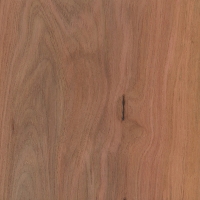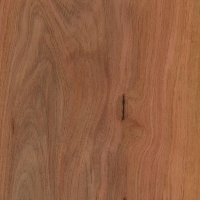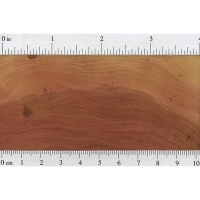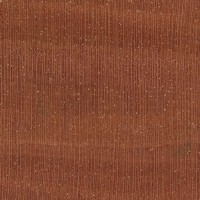 |
Common Name(s): Mountain Mahogany Scientific Name: Cercocarpus spp. Distribution: Western United States and northern Mexico Tree Size: 10-20 ft (3-6 m) tall, 1 ft (.3 m) trunk diameter Average Dried Weight: 69 lbs/ft3 (1,110 kg/m3) Specific Gravity (Basic, 12% MC): .93, 1.11 Janka Hardness: 3,200 lbf (14,230 N) Modulus of Rupture: No data available Elastic Modulus: No data available Crushing Strength: No data available Shrinkage: Radial: 2.3%, Tangential: 4.4%, Volumetric: 6.8%, T/R Ratio: 1.9 |
Color/Appearance: Heartwood is reddish brown. Sapwood is pale yellow or pink, not always sharply demarcated form heartwood. Color of both sapwood and heartwood tends to darken with age.
Grain/Texture: Very fine, even texture; excellent natural luster.
Endgrain: Diffuse-porous or semi-ring porous; solitary and radial multiples, sometimes exclusively solitary; small pores, sometimes arranged into loose/broken rows with differing sized pores, numerous to very numerous; mineral/gum deposits occasionally present; parenchyma not visible or absent; narrow rays, spacing normal.
Rot Resistance: No data available.
Workability: Tends to be difficult to work on account of it’s density and cutting resistance. Turns well.
Odor: No characteristic odor.
Allergies/Toxicity: Besides the standard health risks associated with any type of wood dust, no further health reactions have been associated with Mountain Mahogany. See the articles Wood Allergies and Toxicity and Wood Dust Safety for more information.
Pricing/Availability: Mountain Mahogany is in not rare, but is very seldom harvested for lumber. Its small size, mountainous location, and extreme density put this wood out of practical reach. Small turning blanks are occasionally seen for sale. Expect prices to be fairly high for a domestic hardwood.
Sustainability: This wood species is not listed in the CITES Appendices or on the IUCN Red List of Threatened Species.
Common Uses: Firewood, turned objects, and other small specialty wood objects.
Comments: Not to be confused with true mahogany in the Swietenia genus, Mountain Mahogany is an unrelated species yielding extremely dense wood—among the very densest among trees native to the United States, (with the exception of Desert Ironwood).
Oftentimes just a shrub or small tree, this dense wood is usually found at higher elevations, and its harvesting is generally limited to determined hobbyists with sharp chainsaws.
None available.
 |
 |
 |
 |





If the average dried weight really is 69 lbs a cubic ft then this stuff should sink even in seawater. Anyone know?
Certainly sinks in water. Don’t live near enough the sea to find out for sure, but I imagine it would. Very dense. Just finished up a batch of utensils
Check out this EXTREMELY old curly leaf var. (Cercocarpus ledifolius) near where I live. Part of this tree is actually still alive though most of it has perished. Using my children for scale, you can see that it is a truly massive specimen!
Too bad there is no mention of Native Americans using this wood to make bows . It was harvested annually in Wyoming , a powwow was held and this eventually gave Medicine Bow , Wyoming its’ name .
I got some Cercocarpus wood boles recently from Northern Utah county. They had been bull-dozed down for some big house. I wanted to get some decent wood to saw and see how it looks. I want to go back and get more of the stuff. I needed more batteries for my small chain saw. I would like to make some microscope slides of the wood.
We have a lot of Mountain Mahogany here in Eastern Oregon, many folks use it for smoking meat, turning bowls, making pipes, beautiful sounding flutes, and just really awesome firewood. I love the curvy boles, the wood is extremely heavy and dense, very rot resistant and lasts forever. Old logs can lay on the ground for 100+ years and still be solid, but they grow really slow (like 1” diameter in 75 yrs).
I wonder if this would would make an epic axe handle/shaft!?
Probably not. First, it’s very very heavy. Second, the wood is too brittle for an axe handle.
I have seen them used as handles and I have one on an axe, but it’s a very heavy wood and hard to find straight sections to build longer handles. It is not brittle at all, it’s really strong and almost unbreakable.
Have a friend who has pistol grips made of the stuff. Beautiful, but the fellah who made them said it was a chore requiring a lot of tool sharpening sprinkled with some sailor talk. Even though this craftsman has made several custom grips, he really doesn’t want to do it again with MM.
It breaks VERY easily. In the stands near where I live, dead branches litter the ground EVERYWHERE!
There’s a lot of Alderleaf Mountain Mahogany along the creek on one side of my pasture. Where one large one was cut down a few years ago, there’s about 2 dozen long straight 5, to7 foot suckers. As an experiment I’m going to tie bamboo sticks to some of the nicer ones, and train the ends to grow into shepherds crooks (I raise dairy goats). Then I’ll remove the extras, and lower branches, and hopefully in a year or two I’ll have a usable crook for myself, and a few for gifts.
I am looking at a piece of property to set up a forge and homestead on there is quite a bit of the stuff on the property, would it be suitable for ax handles
Probably not, it’s pretty dense and heavy, hard to work. Maybe something that won’t take a lot of abuse that is more decorative. I bet knife handles would be a great use for it.
Cut from a dead branch in the Blue Mountains in Eastern Oregon.
That’s a good looking piece for knife handles, Thanks for sharing.
I regularly use this species as firewood and in my smoker. It does have a distinct odor, to me like hyper mesquite.
Generally the wood density is greater than 1.0 with the sapwood being somewhat less.
Contact wood cutters in the mountain west and they should be able to find it for you.
Oh, the wood is also extremely rot-resistant but insects, especially carpenter ants, will, eventually make use of deadwood on the forest floor.
I have piles of this in my yard I saved from clearing a firebreak. Makes nice turnings and small items but no such thing as straight grain in this wood. Put a larger piece on my splitter and it just exploded.